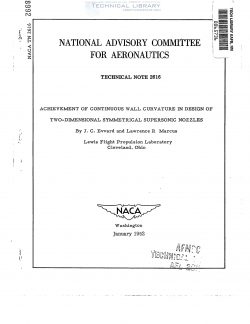naca-tn-2616
- Version
- 36 Downloads
- 324.87 KB File Size
- 1 File Count
- January 9, 2017 Create Date
- January 9, 2017 Last Updated
National Advisory Committee for Aeronautics, Technical Notes - Achievement of Continuous Wall Curvature in Design Two Dimensional Symmetrical Supersonic Nozzles

The method of characteristics was first applied by Prandtl and
Busemann to the evaluation of supersonic flows in 1929 (reference 1).
Since then, a number of expositions (for example, see references 2, 5,
and 4) have described various applications of characteristics to the
design of two-dimensional supersonic nozzles. The problem considered
was to determine wall contours that would transform a uniform or source
flow usually at mach number of unity to a uniform shock—free flow at
some higher Mach number.
The wall contours so determined usually contain discontinuities
in curvature which are tolerable for fixed geometry designs. In varia—
ble mach number flexible-walled nozzles, however, a discontinuity in
curvature implies a multivalued stress at a point, which in turn can
only occur if there is a restraining moment. The design of flexible-
walled supersonic wind tunnels usually does not include provision for
such a-restraining moment and hence the wall fairs the curvature across
the discontinuity. If the characteristic diagram for the tunnel
requires a discontinuity, then imperfections in the actual flow must
appear.
Even if a rigid—walled nozzle is used, the probability that the-
theoretical gas flow will occur is slight. Changes in the ratio of
specific heats, or any condensation of the gas components, or imper-
fections in the corrections for boundary layer can shift the character-
istic pattern along the nozzle wall. The seriousness of such a shift
is minimized if the curvature is continuous and small. Here again noz-
zles with inherent continuity of curvature from the characteristic
pattern are desired.
A plot of wall angles for a conventional supersonic nozzle including
a discontinuity of curvature at the point of inflection is presented in
figure 1. Also shown is a schematic plot on which the discontinuity in
curvature has been eliminated. The auxiliary restrictions which must
be imposed in the design of two—dimensional supersonic nozzles to elim-
inate discontinuity of wall curvature are presented herein. The work
was completed.during May, 1951, at the NAGA.Lewis laboratory.
| File | Action |
|---|---|
| naca-tn-2616 Achievement of Continuous Wall Curvature in Design Two Dimensional Symmetrical Supersonic Nozzles.pdf | Download |
Comment On This Post